The AMD Radeon VII Review: An Unexpected Shot At The High-End
by Nate Oh on February 7, 2019 9:00 AM ESTWolfenstein II: The New Colossus (Vulkan)
id Software is popularly known for a few games involving shooting stuff until it dies, just with different 'stuff' for each one: Nazis, demons, or other players while scorning the laws of physics. Wolfenstein II is the latest of the first, the sequel of a modern reboot series developed by MachineGames and built on id Tech 6. While the tone is significantly less pulpy nowadays, the game is still a frenetic FPS at heart, succeeding DOOM as a modern Vulkan flagship title and arriving as a pure Vullkan implementation rather than the originally OpenGL DOOM.
Featuring a Nazi-occupied America of 1961, Wolfenstein II is lushly designed yet not oppressively intensive on the hardware, something that goes well with its pace of action that emerge suddenly from a level design flush with alternate historical details.
The highest quality preset, "Mein leben!", was used. Wolfenstein II also features Vega-centric GPU Culling and Rapid Packed Math, as well as Radeon-centric Deferred Rendering; in accordance with the preset, neither GPU Culling nor Deferred Rendering was enabled.
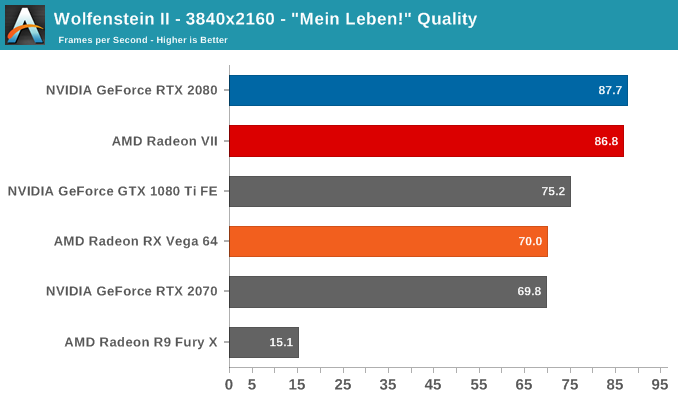
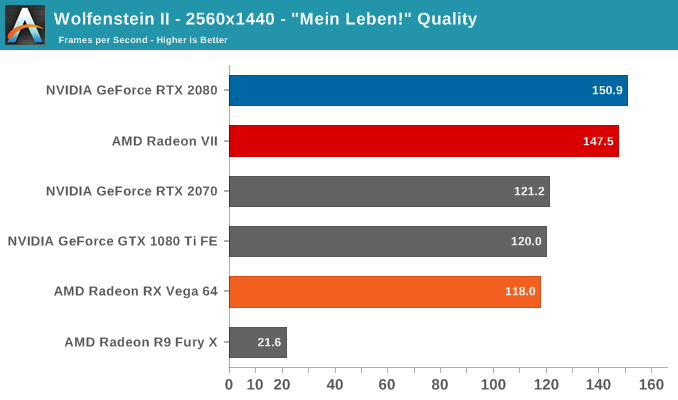
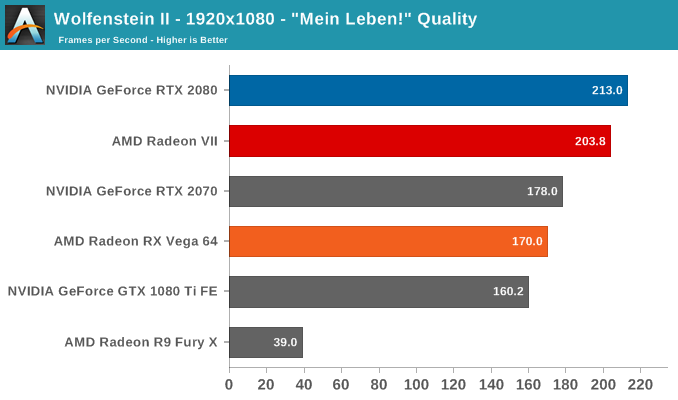
We've known that Wolfenstein II enjoys its framebuffer, and to explain the obvious outlier first the Fury X's 4GB HBM1 simply isn't enough for smooth gameplay. The resulting performance is better conveyed by 99th percentile framerates, and even at 1080p the amount of stuttering renders the game unplayable.
Returning to the rest of the cards, Wolfenstein II's penchant for current-generation architectures (i.e. Turing, Vega) is again on display. Here, the Pascal-based GTX 1080 Ti FE isn't in the running for best-in-class, with the RTX 2080 taking pole and Radeon VII in a close second. Once again, the raw lead in average frametimes grows at lower resolutions, indicating that the Radeon VII is indeed a few shades slower than the reference RTX 2080, but judging from 99th percentile data the real-world difference is close to nil.
Compared to the RX Vega 64, the performance uplift is exactly 24% at 4K and 25% at 1440p, an amusing coincidence given the guidance of 25% given earlier.
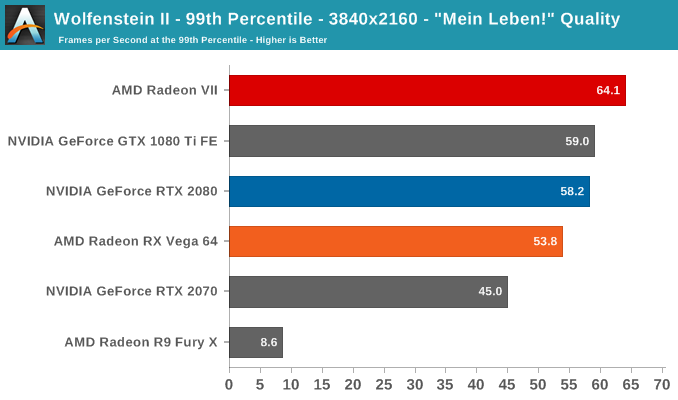
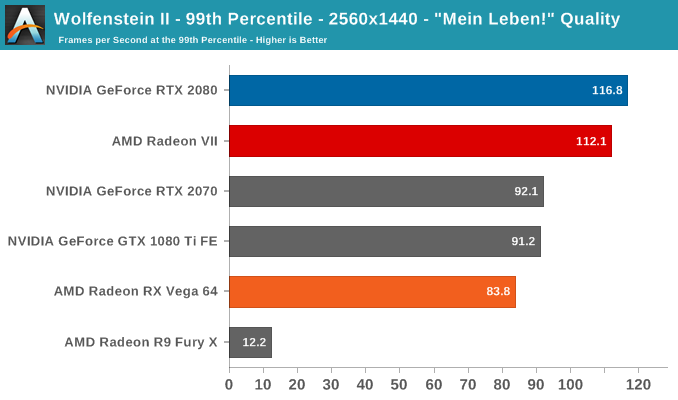
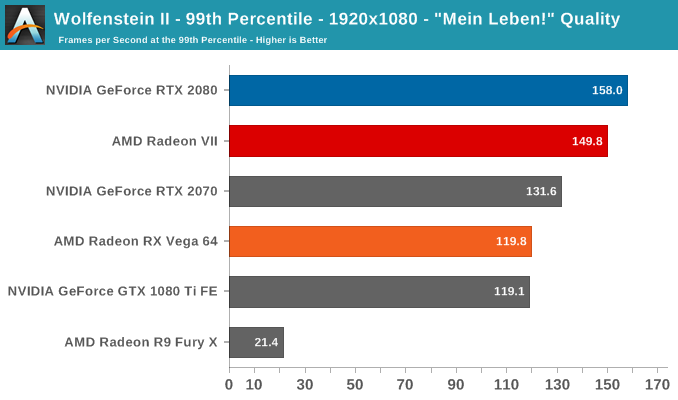


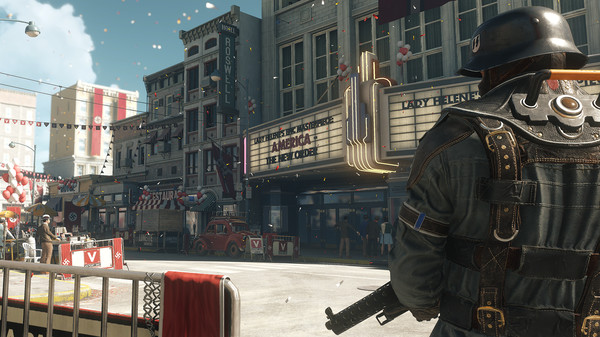








289 Comments
View All Comments
Alistair - Thursday, February 7, 2019 - link
Because everyone is already playing Anthem at 4k 60fps with a $400 card? Ray tracing is totally useless and we need way more rasterization performance per dollar than we have right now. Give me a 7nm 2080 ti without the RT cores for $699 and then we'll talk.eva02langley - Friday, February 8, 2019 - link
Fair, the main objective of gaming GPU are shaders per $. Gameworks gimmick are not something I call a selling factor... and Nvidia is forced to cook their books because of it.RSAUser - Thursday, February 7, 2019 - link
Why are you adding the Final Fantasy benchmark when it has known bias issues?Zizy - Thursday, February 7, 2019 - link
Eh, 2080 is slightly better for games and costs the same, while unfortunately MATLAB supports just CUDA so I can't even play with compute.Hul8 - Thursday, February 7, 2019 - link
On page 19, the "Load GPU Temperatur - FurMark" graph is duplicated.Ryan Smith - Thursday, February 7, 2019 - link
Thanks. The FurMark power graph has been put back where it belongs.schizoide - Thursday, February 7, 2019 - link
Man, I've never seen such a hostile response to an Anandtech article. People need to relax, it's just a videocard.I don't see this as a win for AMD. Using HBM2 the card is expensive to produce, so they don't have a lot of freedom to discount it. Without a hefty discount, it's louder, hotter, and slower than a 2080 at the same price. And of course no ray-tracing, which may or may not matter, but I'd rather have it just in case.
For OpenCL work it's a very attractive option, but again, that's a loser for AMD because they ALREADY sold this card as a workstation product for a lot more money. Now it's discounted to compete with the 2080, meaning less revenue for AMD.
Even once the drivers are fixed, I don't see this going anywhere. It's another Vega64.
sing_electric - Thursday, February 7, 2019 - link
There's still a lot of people for whom a Radeon Instinct was just never going to happen, INCLUDING people who might have a workstation where they write code that will mostly run on servers, and it means you can run/test your code on your workstation with a fairly predictable mapping to final server performance.As Nate said in the review, it's also very attractive to academics, which benefits AMD in the long run if say, a bunch of professors and grad students learn to write ML/CL on Radeon before say, starting or joining companies.
schizoide - Thursday, February 7, 2019 - link
Yes, it's attractive to anyone who values OpenCL performance. They're getting workstation-class hardware on the cheap. But that does devalue AMD's workstation productline.Manch - Thursday, February 7, 2019 - link
Not really. The instinct cards are still more performant. They tend to be bought by businesses where time/perf is more important than price/perf.